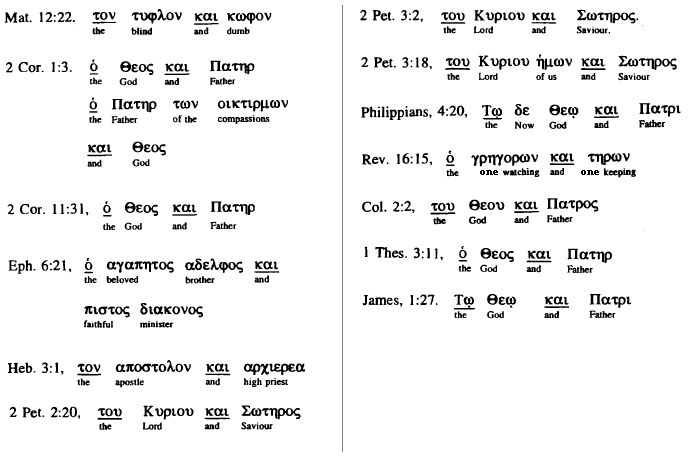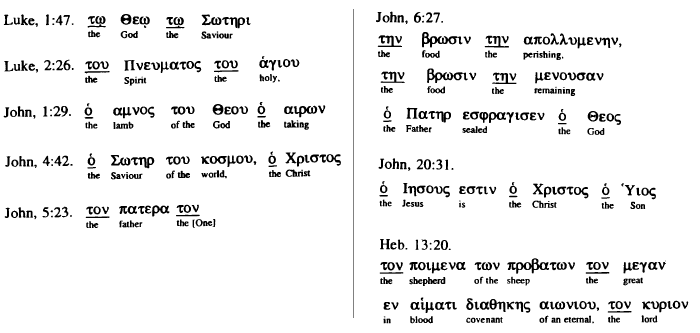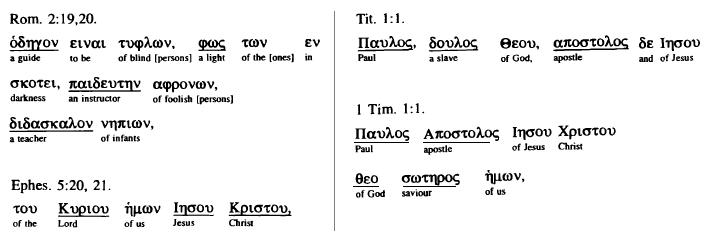Main Menu
PFRS Home
About PFRS
Doctrinal Statement
Policy Information
Help Spread the Word
Sharp's Rule
Resources
Doctrinal Studies
PFRS Commentary
NT Translation Project

|
Granville Sharp's Six Rules
Remarks on the uses of the Definite Article in the Greek Text of the
New Testament, Containing Many New Proofs of the Divinity of Christ,
from Passages which are Wrongly Translated in the Common English Version.
By Granville Sharp - 10th June, 1778
Rule I.
When the copulative kai connects two nouns of the same case, [viz. nouns (either substantive or adjective, or participles) of personal description respecting office, dignity, affinity, or connection, and attributes, properties, or qualities, good or ill,]
if the article ho, or any of its cases, precedes the first of the said nouns or participles, and is not repeated before the second noun or participle, the latter always relates to the same person that is expressed or described by the first noun or participle: i.e. it denotes farther
description of the first-named person, as -

And there is no exception or instance of the like mode of expression, that I know of, which necessarily requires a construction different from what is here laid down, EXCEPT the nouns be proper names, or in the plural number; in which cases there are many exceptions; though there are not wanting examples, even of plural
nouns, which are expressed exactly agreeable to this rule. ...
The rules which follow are intended only to illustrate the particularity of the several sentences which fall under the first rule, by showing, in other sentences, the different senses that are occasioned by adding, omitting, or repeating, the article, as well with the copulative as without it.
Rule II.
A repetition of the article before the second noun, if the copulative be omitted, will have the same effect and power: for, it denotes a farther description of the same person, property, or thing, that is expressed by the first noun. Examples:

Except when genitive cases depend on one another in succession, as -

Rule III.
And the omission of the copulative between two or more nouns (of the same case) of personal description or application, even without the article before the second noun, will have the same effect: viz. will denote farther description of the same person, property, or thing, that is expressed by the first noun, as in the following examples:

Rule IV.
Yet it is otherwise when the nouns are not of personal description or application; for then they denote distinct things or qualities: as -

Rule V.
And as also when there is no article before the first noun, the insertion of the copulative kai before the next noun, or name, of the same case, denotes a different person or thing from the first: as in the following examples -

Rule VI.
And as the insertion of the copulative kai between nouns of the same case, without articles, (according to the fifth rule,) denotes that the second noun expresses a different person, thing, or quality, from the preceding noun, so, likewise, the same effect attends the copulative when each of the nouns are preceded by articles, as in the following examples -

Except distinct and different actions are intended to be attributed to one and the same person; in which case, if the sentence is not expressed agreeably to the three first rules, but appears to be an exception to this sixth rule, or even to the fifth, (for, this exception relates to both rules,) the context must explain or point out plainly the person to whom the two nouns relate: as in -

Exceptions to the fifth rule,
and in -

Exceptions to the sixth rule.
The various uses of the article and copulative, expressed in the last five rules and their exceptions, must amply illustrate, to every attentive reader, the difference and particularity of those sentences which fall under the first principal rule; and therefore I may now proceed with more confidence to point out several important corrections that ought to be made in our common translation of the New Testament, if the several sentences, which fall under the first rule, be duly weighed and considered; - corrections which may be fairly defended, I apprehend,
by the authority of the several examples from which those rules were formed.
Notes on Sharp's Rules
By Tim Warner
Sharp's rules are usually illustrated with a three, four, or five letter designation, as follows: TSKS, TSTS, TSS, SKS, TSKTS.
"T" represents the definite article (the) in Greek.
"S" represents the "substantive" which can be a noun, adjective, or
participle.
"K" represents the copulative "kai" (the Greek word for "and").
Therefore, the first rule, where the construction in Greek is "article - substantive - kai - substantive" would be illustrated as a "TSKS" construction.
Rule I (TSKS, article - substantive - kai - substantive {singular, personal})
Sharp made it clear that his intent was only to prove rule I absolutely without exception. The other five rules are given to show contrast with rule I. However, the other five are quite helpful to the interpreter as well. Sharp himself claimed that Rule I was absolutely without exception in the New Testament when applied to personal, singular nouns, that are not proper names. However, the same rule holds true in most cases even with plural personal nouns. A typical TSKS construction would be Eph. 1:3, "the God and Father." Both "God" and "Father" refer to the same person.
Rule II (TSTS, article - substantive - article - substantive {personal})
The second rule states that even with the article before the second noun, if "kai" is omitted, the effect is the same as the first rule. Both nouns refer to the same person.
Rule III (TSS, article - substantive - substantive {personal})
The third rule modifies the second, both nouns still refer to the same person, whether the article is included or omitted before the second noun, as long as "kai" is also omitted.
Rule IV (TSS, article - substantive - substantive {non-personal})
The fourth rule is really an exception to the third rule. If the nouns are non-personal (things), and "kai" and the article are omitted, the effect is just the opposite -- they refer to different things.
Rule V (SKS, substantive - kai - substantive {personal or non-personal})
The fifth rule specifically applies to both personal and non personal nouns. When neither noun has the article, they refer to different persons or things.
Rule VI (TSKTS, article - substantive - kai - article - substantive {personal or non-personal})
The sixth rule also applies specifically to both personal and non-personal nouns. The effect is exactly the same as the fifth rule. When both nouns have the definite article, they refer to different things. Sharp was careful to explain the exceptions, which apply to both the fifth and sixth rules. Notice that only personal nouns may fall under the exception, which is: when both nouns are clearly stated within the context to refer to the same person. Examples are Thomas' exclamation, "My Lord and my God." Since in the context he was clearly addressing both nouns to Jesus' person, this falls within the exception. Another example, where the same person is addressed with two nouns, is Jesus' statement, "I am the first and the last." Since Jesus specifically applied both titles to Himself within the context, this also falls within the exception to the sixth rule. When no such direct statement occurs within the context applying both nouns to a single person, the nouns refer to different things or persons. Sharp was clear that any alleged exceptions to the fifth or sixth rules MUST have a clear singular personal application or they cannot be considered exceptions. A case in point is Matt. 28:19. "the name of the Father and the Son and the Holy Spirit" (TSKTSKTS). The use of the article before each noun indicates each of these are distinct persons.
A similar construction occurs in 1 John 2:22 & 2 John 1:9, "the Father and the Son" (TSKTS). Both of these passages, when viewed using Sharp's sixth rule, refute the Modalist (Oneness) view which denies the Trinity, claiming that Jesus and the Father are one and the same person.
Many modern Greek Grammars include a section on Sharp's rule. Here is Vaughn's & Gideon's summary.
"If two nouns of the same case are connected by a "kai" [and] and the article is used with both nouns, they refer to different persons or things. If only the first noun has the article, the second noun refers to the same person or thing referred to in the first." (Vaughn and Gideon, A Greek Grammar of the New Testament, Nashville: Broadman Press, 1979, p. 83.)
You may notice that this version of Sharp's first rule does not limit it to exclusively personal, singular nouns, but also includes plural and non-personal nouns in the first rule. Daniel B. Wallace (Greek Grammar Beyond the Basics, pp. 278-290) has noted that when non-personal or plural nouns appear in a TSKS construction, at least some kind of unity is being expressed between the substantives. They may be:
a) distinct but united
b) overlapping entities
c) first entity subset of second
d) second entity subset of first
e) both entities identical
As a general exegetical rule, we have found that the following general rule is helpful.
"TSKTS or SKS- If two nouns of the same case are connected by a "kai" (and) and the article is used with BOTH nouns (TSKTS), or with neither noun (SKS), the nouns point to different persons, things, or qualities. That is, the nouns are being distinguished in the context for a specific reason. This is true even when both nouns are applicable to the same person. eg., "I am the Alpha and Omega." The two nouns are opposites, and are being distinguished as extreme opposites, even though Jesus claims both for Himself.
TSKS - If only the first noun has the article, the second noun refers to the same person referred to in the first when the nouns are singular, personal, and not proper names. When only the first noun has the article in plural or non-personal constructions, the nouns are being united for a purpose. In this case, even though the nouns themselves may individually refer to different things, qualities, or persons, they are being united for a specific reason in the context.
For example, "the scribes and Pharisees." In this TSKS construction the writer meant to unite the two groups in pointing out their common opposition to Jesus, even though the two groups are completely distinct individually.
|